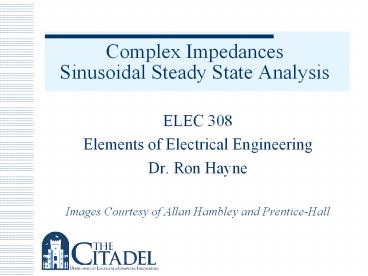Complex Impedances Sinusoidal Steady State Analysis PowerPoint PPT Presentation
Title: Complex Impedances Sinusoidal Steady State Analysis
1
Complex ImpedancesSinusoidal Steady State
Analysis
- ELEC 308
- Elements of Electrical Engineering
- Dr. Ron Hayne
- Images Courtesy of Allan Hambley and Prentice-Hall
2
Complex Impedances
- Inductance and Capacitance represented as Complex
Numbers
3
Inductance
4
Inductance
5
Impedance
- Ohms Law in phasor form
- Phasor voltage equals impedances times the phasor
current - Impedance is COMPLEX, in general
- Can be strictly REAL
- Impedance Resistance
- Can be strictly IMAGINARY
- Impedance Reactance
- Both inductances and capacitances
6
Capacitance
7
Capacitance
8
Resistance
- The phasors are related by
- VR RIR
9
Exercise 5.7
10
Exercise 5.8
11
Steady-State Circuit Analysis
- Circuit Analysis Using Phasors and Impedances
- Replace the time descriptions of voltage and
current sources with corresponding phasors. - All of the sources must have the SAME frequency!
- Replace inductances, capacitances, and
resistances with their corresponding impedances. - Analyze the circuit using any of the techniques
from Chapters 1 and 2 by performing the
calculations with complex arithmetic.
12
Example 5.4
- Find the steady-state current for the circuit
shown below. Also, find the phasor voltage
across each element and construct a phasor
diagram.
13
Phasor Diagram
14
Example 5.5
- Series and Parallel Combinations of Complex
Impedances - Find the voltage vc(t) in steady state. Find the
phasor current through each element, and
construct a phasor diagram showing the currents
and source voltage.
15
Phasor Diagram
16
Exercise 5.9
- Find i(t) in the circuit below. What is the
phase relationship between vs(t) and i(t)?
17
Exercise 5.9
- Find i(t) in the circuit below. What is the
phase relationship between vs(t) and i(t)?
18
Exercise 5.10
- Find the phasor voltage and current for each
circuit element.
19
Summary
- Complex Impedances
- Inductance
- Capacitance
- Resistance
- Sinusoidal Steady State Analysis
- Ohms Law
- KVL (Mesh-Current Analysis)
- KCL (Node-Voltage Analysis)
PowerShow.com is a leading presentation sharing website. It has millions of presentations already uploaded and available with 1,000s more being uploaded by its users every day. Whatever your area of interest, here you’ll be able to find and view presentations you’ll love and possibly download. And, best of all, it is completely free and easy to use.
You might even have a presentation you’d like to share with others. If so, just upload it to PowerShow.com. We’ll convert it to an HTML5 slideshow that includes all the media types you’ve already added: audio, video, music, pictures, animations and transition effects. Then you can share it with your target audience as well as PowerShow.com’s millions of monthly visitors. And, again, it’s all free.
About the Developers
PowerShow.com is brought to you by CrystalGraphics, the award-winning developer and market-leading publisher of rich-media enhancement products for presentations. Our product offerings include millions of PowerPoint templates, diagrams, animated 3D characters and more.

